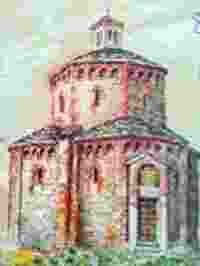Mark the Evangelist
 St Mark, evangelist and apostle
St Mark, evangelist and apostle
A key figure in Christianity, known for writing the second canonical Gospel.
Born in Palestine or Cyprus around the year 20 A.D. Barnabas’s cousin initially accompanied the apostle Paul on his first trip to Cyprus. Then Peter joined, becoming his disciple and secretary. He wrote his Gospel, based on the teachings of Peter.
Summary:
-
Saint Mark Biographical Notes
-
Saint Mark parables index
Join us
Saint Mark Biography and life
Mark is a Latin name, which occurs eight times in the New Testament, in three of which however it is accompanied by the Hebrew name John.
The critics are now all in agreement in believing that it is always the same person with two names, since what is said of John, perfectly matches with what is said of Marco and vice versa.
Acts show that John Mark's mother, called Mary, owned a house in Jerusalem, which was a place where Christians met, and to which St. Peter went to knock when he was miraculously freed from prison.
Mark's family therefore had to have special relations with Saint Peter, and it is highly probable that Mark was baptized by the prince of the Apostles himself.
Mark was not a disciple of the Lord, however many commentators claim that he witnessed some episode of the passion, and identify him with that young man who fled naked from the hands of the guards sent to arrest Jesus in the garden of Gethsemane.
It is certain that he accompanied Paul and Barnabas in the evangelization of the island of Cyprus and part of Panfilia, but when he arrived in Perge, he abandoned them and returned to Jerusalem.
Paul was disgusted with his way of proceeding, and in his second mission, despite Barnabas' requests, he no longer wanted him as a companion.
Later, however, he reconciled with him, and had him with him in Rome in his first imprisonment and during the second imprisonment he wrote to Timothy to bring Mark with him to Rome, stating that it was useful to him in the ministry.
He was a collaborator of the apostle Paul and especially of Peter who preferred him. Some writers say that Mark preached the gospel in lower Egypt, and founded the Church of Alexandria, of which he was the first bishop.
Peter publicly preached the word of God in Rome, and Mark, who for a long time followed Saint Peter and memorized his teachings, was prayed by many present to put in writing what the Apostle had preached. So Mark composed the Gospel, giving it to those who asked for it. Initially this gospel was called the Gospel of Peter.
This second Gospel was written in Rome and intended for Roman Christians. And this hypothesis is fully confirmed by examining the book. Indeed, it is certain that Mark does not write for Jewish readers, since he never mentions the law and only twice appeals to the Scripture of the A.T. because it assumes that its readers do not know Palestine, and therefore gives the most minute geographical and topographical information.
Many clues suggest that Marco was writing for Latin readers. Latinisms are frequent in his Gospel, of which moreover no explanation is given. Since Mark wrote the second Gospel for the Romans, some believe that he had used the Latin language, others that he wrote in Greek.
The date of composition of the probable Gospel of Mark should be established around 65 and was used by Luke.
In writing his Gospel, St. Mark wanted to reproduce the preaching of Peter, and therefore the purpose for which the prince of the Apostles himself aimed to preach to the Romans, that is, to prove that Jesus is true God, master of all, who died for our redemption. , which it is necessary to obey by accepting his doctrine and practicing his teachings.
Saint Mark Parables Index
- The sower
- The slaves who await
- The evil tenants
- The seed that grows in secret
- Mustard grain
- The fig
 St Mark, evangelist and apostle
St Mark, evangelist and apostle